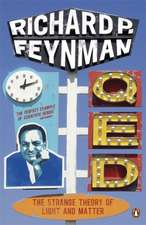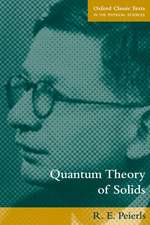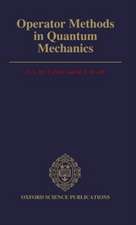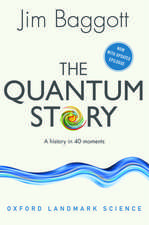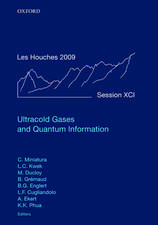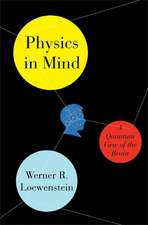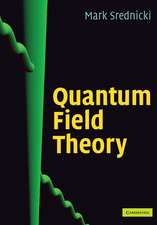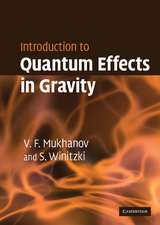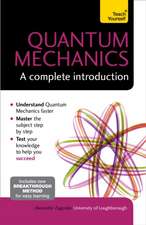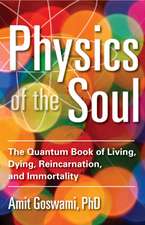Quantum Mechanics: Symbolism of Atomic Measurements
Autor Julian Schwinger Editat de Berthold-Georg Englerten Limba Engleză Hardback – 26 feb 2001
| Toate formatele și edițiile | Preț | Express |
|---|---|---|
| Paperback (1) | 539.82 lei 6-8 săpt. | |
| Springer Berlin, Heidelberg – 22 sep 2011 | 539.82 lei 6-8 săpt. | |
| Hardback (1) | 716.69 lei 6-8 săpt. | |
| Springer Berlin, Heidelberg – 26 feb 2001 | 716.69 lei 6-8 săpt. |
Preț: 716.69 lei
Preț vechi: 843.16 lei
-15% Nou
Puncte Express: 1075
Preț estimativ în valută:
137.14€ • 146.65$ • 114.34£
137.14€ • 146.65$ • 114.34£
Carte tipărită la comandă
Livrare economică 18 aprilie-02 mai
Preluare comenzi: 021 569.72.76
Specificații
ISBN-13: 9783540414087
ISBN-10: 3540414088
Pagini: 502
Ilustrații: XIV, 484 p.
Dimensiuni: 155 x 235 x 37 mm
Greutate: 0.97 kg
Ediția:2001
Editura: Springer Berlin, Heidelberg
Colecția Springer
Locul publicării:Berlin, Heidelberg, Germany
ISBN-10: 3540414088
Pagini: 502
Ilustrații: XIV, 484 p.
Dimensiuni: 155 x 235 x 37 mm
Greutate: 0.97 kg
Ediția:2001
Editura: Springer Berlin, Heidelberg
Colecția Springer
Locul publicării:Berlin, Heidelberg, Germany
Public țintă
GraduateCuprins
Prologue.- A. Fall Quarter: Quantum Kinematics.- 1 Measurement Algebra.- 2 Continuous q, p Degree of Freedom.- 3 Angular Momentum.- 4 Galilean Invariance.- B. Winter Quarter: Quantum Dynamics.- 5 Quantum Action Principle.- 6 Elementary Applications.- 7 Harmonic Oscillators.- 8 Hydrogenic Atoms.- C. Spring Quarter: Interacting Particles.- 9 Two-Particle Coulomb Problem.- 10 Identical Particles.- 11 Many-Electron Atoms.- 12 Electromagnetic Radiation.
Recenzii
From the reviews:
"Quantum Mechanics: Symbolism of Atomic Measurements is not just another textbook on quantum mechanics. Rather, it contains truly novel elements of both content and style. In particular, Schwinger begins his treatment not with de Broglie waves or the Schrödinger equation but rather with the measurement process. His idea is to derive, or at least make plausible, the formalism of state vectors, bras and kets, by reference to quantum measurements such as the Stern-Gerlach experiment. This [...] is simply the basis of a new way of teaching quantum mechanics. This opening chapter should be of interest to all scholars of quantum theory and might form a new topic of research for philosophers of quantum mechanics." (Contemporary Physics, 44/2, 2003)
"There are dozen of excellent textbooks on the market. But this one really is different." (T. Kibble, The Times Higher Education Supplement, 2001)
"The material covered is superficially similar to that of a typical graduate quantum mechanics course [...] However, each chapter has beautiful and unusual treatments of familiar topics. [...] This book would make an outstanding supplement and reference for a graduate quantum mechanics course. Theoretical physicists will delight in this wonderful book, which should be available in the library system of any institution with a research or graduate program in physics. Graduate students through professionals." (CHOICE, Dec. 2001)
"The book is a tour-de-force. Once the groundwork is laid, he goes into subjects with the mathematical virtuosity for which he was famous – not advanced mathematics, but the incredible use of simple mathematics. … there are gems throughout the book. … it is a wonderful book for a professor to own, like Feyman’s lectures, because there is so much to learn from it. … The book was lovingly edited from some UCLA lecture notes, by Berthold-Georg Englert, a longtime student andassistant of Schwinger’s … ." (Daniel Greenberger, American Journal of Physics, Vol 71 (9), 2003)
"Editor Englert has performed a service for physicists everywhere by making available this book, which is based on Schwinger’s unpublished UCLA lecture notes. … each chapter has beautiful and unusual treatments of familiar topics. … There are excellent problems at the end of each chapter. This book would make an outstanding supplement and reference for a graduate quantum mechanics course. Theoretical physicists will delight in this wonderful book, which should be available in the library system of any institution with a research or graduate program … ." (M. C. Ogilvie, CHOICE, December, 2001)
"The book commences with an absorbing prologue in which Schwinger talks us through the development of quantum mechanic and quantum field theory in an easy conversational style. … The book is packed with exercises for the reader to attempt. … Anyone who works religiously through these exercises will acquire a thoroughly adequate command of quantum mechanics." (W. Cox, Mathematical Reviews, Issue 2002 h)
"Quantum mechanics: Symbolism of Atomic Measurements is not just another textbook on quantum mechanics. Rather, it contains truly novel elements of both content and style. … This opening chapter should be of interest to all scholars of quantum theory and might form a new topic of research for philosophers of quantum mechanics. Throughout the text, new material is presented at a breathless pace. All the usual elements of the subject are there, but Schwinger’s presentation reveals surprises in even the most familiar of these." (S. M. Barnett, Contemporary Physics, Vol. 44 (2), 2003)
"In the beginning, the editor has added an important material in the form of a prologue … . This is one of the best treatments of the philosophy of quantum mechanics, which I have come across. … One of the major features of the book is theincorporation of a large number of problems … . the contents of the problems are well integrated in the text and have become part of it. This has caused a rich and tight structure of the logical arguments." (S. S. Bhattacharyya, Indian Journal of Physics, Vol. 76B (3), 2002)
"This unique textbook is based upon the lecture notes that Julian Schwinger wrote up for the students of the quantum mechanics course … . this book would probably make an ideal quantum mechanics reference … . There are a large number of problems included at the end of each chapter, which comprise an excellent resource for any lecturer … . this textbook is a unique resource, which provides an insight into the thoughts and deliberations of one of this century’s giants of quantum mechanics." (P. C. Dastoor, The Physicist, Vol. 38 (5), 2001)
"There are dozens of excellent textbooks on the market. But this one really is different. … there is a carefully argued historical and philosophical prologue that sets the scene, centred on the two key features of quantum physics – atomicity and its probabilistic character; this alone would make the book worthwhile. The emphasis on discrete variables is a very modern approach… . To a theoretical physicist, this book is a delight and a wonderful resource. … This is a book I shall treasure." (Tom Kibble, Times Higher Education Supplement, September, 2001)
"Quantum Mechanics: Symbolism of Atomic Measurements is not just another textbook on quantum mechanics. Rather, it contains truly novel elements of both content and style. In particular, Schwinger begins his treatment not with de Broglie waves or the Schrödinger equation but rather with the measurement process. His idea is to derive, or at least make plausible, the formalism of state vectors, bras and kets, by reference to quantum measurements such as the Stern-Gerlach experiment. This [...] is simply the basis of a new way of teaching quantum mechanics. This opening chapter should be of interest to all scholars of quantum theory and might form a new topic of research for philosophers of quantum mechanics." (Contemporary Physics, 44/2, 2003)
"There are dozen of excellent textbooks on the market. But this one really is different." (T. Kibble, The Times Higher Education Supplement, 2001)
"The material covered is superficially similar to that of a typical graduate quantum mechanics course [...] However, each chapter has beautiful and unusual treatments of familiar topics. [...] This book would make an outstanding supplement and reference for a graduate quantum mechanics course. Theoretical physicists will delight in this wonderful book, which should be available in the library system of any institution with a research or graduate program in physics. Graduate students through professionals." (CHOICE, Dec. 2001)
"The book is a tour-de-force. Once the groundwork is laid, he goes into subjects with the mathematical virtuosity for which he was famous – not advanced mathematics, but the incredible use of simple mathematics. … there are gems throughout the book. … it is a wonderful book for a professor to own, like Feyman’s lectures, because there is so much to learn from it. … The book was lovingly edited from some UCLA lecture notes, by Berthold-Georg Englert, a longtime student andassistant of Schwinger’s … ." (Daniel Greenberger, American Journal of Physics, Vol 71 (9), 2003)
"Editor Englert has performed a service for physicists everywhere by making available this book, which is based on Schwinger’s unpublished UCLA lecture notes. … each chapter has beautiful and unusual treatments of familiar topics. … There are excellent problems at the end of each chapter. This book would make an outstanding supplement and reference for a graduate quantum mechanics course. Theoretical physicists will delight in this wonderful book, which should be available in the library system of any institution with a research or graduate program … ." (M. C. Ogilvie, CHOICE, December, 2001)
"The book commences with an absorbing prologue in which Schwinger talks us through the development of quantum mechanic and quantum field theory in an easy conversational style. … The book is packed with exercises for the reader to attempt. … Anyone who works religiously through these exercises will acquire a thoroughly adequate command of quantum mechanics." (W. Cox, Mathematical Reviews, Issue 2002 h)
"Quantum mechanics: Symbolism of Atomic Measurements is not just another textbook on quantum mechanics. Rather, it contains truly novel elements of both content and style. … This opening chapter should be of interest to all scholars of quantum theory and might form a new topic of research for philosophers of quantum mechanics. Throughout the text, new material is presented at a breathless pace. All the usual elements of the subject are there, but Schwinger’s presentation reveals surprises in even the most familiar of these." (S. M. Barnett, Contemporary Physics, Vol. 44 (2), 2003)
"In the beginning, the editor has added an important material in the form of a prologue … . This is one of the best treatments of the philosophy of quantum mechanics, which I have come across. … One of the major features of the book is theincorporation of a large number of problems … . the contents of the problems are well integrated in the text and have become part of it. This has caused a rich and tight structure of the logical arguments." (S. S. Bhattacharyya, Indian Journal of Physics, Vol. 76B (3), 2002)
"This unique textbook is based upon the lecture notes that Julian Schwinger wrote up for the students of the quantum mechanics course … . this book would probably make an ideal quantum mechanics reference … . There are a large number of problems included at the end of each chapter, which comprise an excellent resource for any lecturer … . this textbook is a unique resource, which provides an insight into the thoughts and deliberations of one of this century’s giants of quantum mechanics." (P. C. Dastoor, The Physicist, Vol. 38 (5), 2001)
"There are dozens of excellent textbooks on the market. But this one really is different. … there is a carefully argued historical and philosophical prologue that sets the scene, centred on the two key features of quantum physics – atomicity and its probabilistic character; this alone would make the book worthwhile. The emphasis on discrete variables is a very modern approach… . To a theoretical physicist, this book is a delight and a wonderful resource. … This is a book I shall treasure." (Tom Kibble, Times Higher Education Supplement, September, 2001)
Textul de pe ultima copertă
Julian Schwinger, who shared the 1965 Nobel Prize for physics with Richard Feynman and Sin-Itiro Tomonaga for his pioneering work on quantum electrodynamics, had a considerable influence on the conceptual development of modern quantum field theory.
In addition to being an extremely productive researcher he was also a brilliant teacher, and this book demonstrates his outstanding ability to expose a difficult subject in a clear and concise style. In marked contrast to many textbooks on quantum physics, the whole of quantum kinematics and the underlying quantum action principle, which now bears his name, are derived through a systematic analysis of experimental phenomena, thus avoiding the ad hoc postulates of the axiomatic approach. Many applications, all worked out in detail, follow and culminate in an introduction to quantum electrodynamics.
A unique legacy, these lecture notes of Schwingers course held at the University of California at Los Angeles were carefully edited by his former collaborator Berthold-Georg Englert and constitute both a self-contained textbook on quantum mechanics and an indispensable source of reference on this fundamental subject by one of the foremost thinkers of twentieth century physics.
In addition to being an extremely productive researcher he was also a brilliant teacher, and this book demonstrates his outstanding ability to expose a difficult subject in a clear and concise style. In marked contrast to many textbooks on quantum physics, the whole of quantum kinematics and the underlying quantum action principle, which now bears his name, are derived through a systematic analysis of experimental phenomena, thus avoiding the ad hoc postulates of the axiomatic approach. Many applications, all worked out in detail, follow and culminate in an introduction to quantum electrodynamics.
A unique legacy, these lecture notes of Schwingers course held at the University of California at Los Angeles were carefully edited by his former collaborator Berthold-Georg Englert and constitute both a self-contained textbook on quantum mechanics and an indispensable source of reference on this fundamental subject by one of the foremost thinkers of twentieth century physics.
Caracteristici
Julian Schwinger was one of the most famous physicists of the 20th century and was awarded the Nobel prize for his research in quantum physics Includes supplementary material: sn.pub/extras

